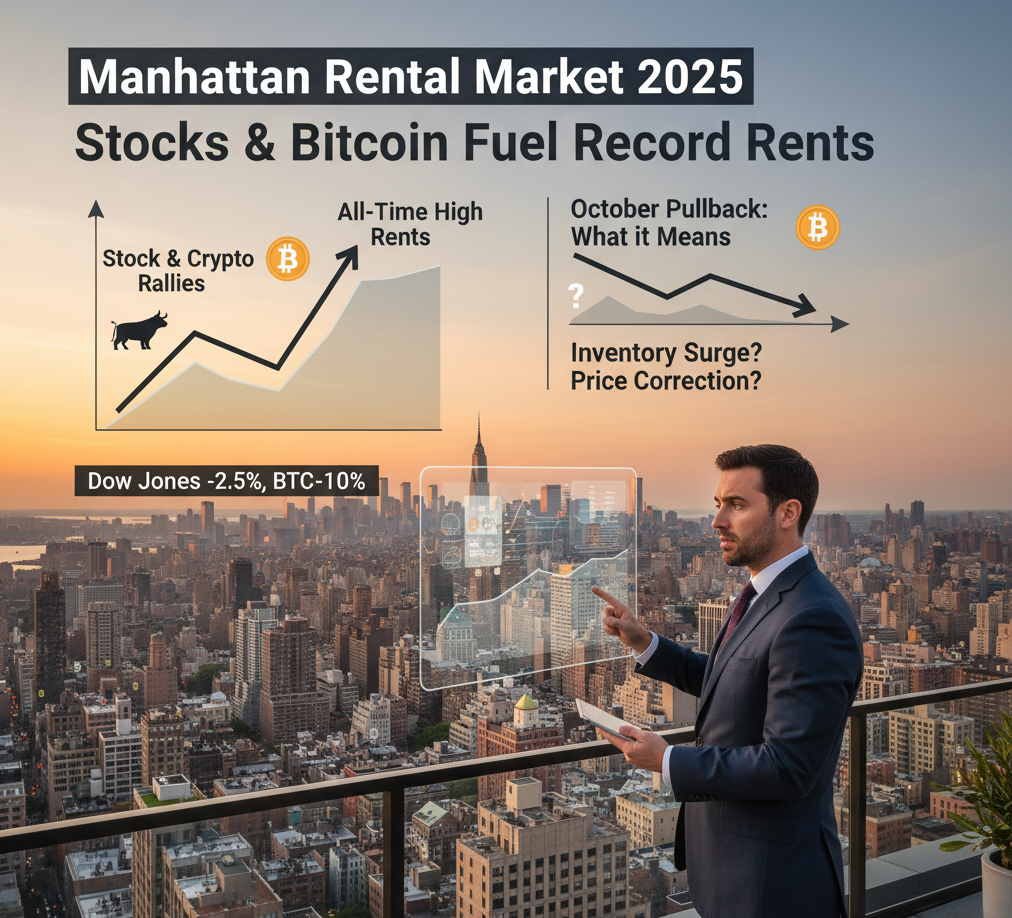Manhattan Rental Market 2025: How Stock and Bitcoin Rallies Drove Record Rents — and What the October Pullback Means

Manhattan’s rental market in 2025 has been nothing short of historic. Throughout spring and summer, median rents soared to unprecedented levels—fueled by booming wealth from Wall Street, surging Bitcoin prices, and a deepening housing supply crunch. But as of October 2025, a cooling trend has finally emerged, marking the first signs of stabilization after months of relentless growth.
Let’s break down what’s driving the shift, what caused the surge, and where Manhattan rents could go next.
Manhattan Rents Hit Record Highs in 2025
Throughout 2025, Manhattan renters faced record-breaking prices.
- July 2025: Median rent hit $4,995, up 7% year-over-year and 2% from June — the highest on record.
- August 2025: Rents remained elevated at $4,722, as bidding wars continued amid a historic shortage of available apartments.
- September 2025: Median rent climbed again to $4,972, up 8% year-over-year, but with growth slowing to just 0.2% month-over-month — the first sign of plateauing.
Luxury apartments and non-doorman buildings saw the biggest increases, showing that demand remained strong at both the premium and affordable ends of the market.
Vacancy rates stayed near record lows, with available listings down roughly 20% compared to 2024. Tight inventory and high-income renters pushed the market to levels unseen before.
Why Manhattan Rents Surged to Record Levels
Several overlapping factors contributed to the 2025 rental spike — from global market trends to local policy shifts.
1. Stock Market Wealth Effects
The S&P 500 and NASDAQ hit all-time highs by mid-2025, lifting investor wealth and consumer confidence. Wall Street bonuses and liquidity gains spilled over into Manhattan’s real estate market, driving up demand for luxury rentals. When markets boom, high earners tend to rent or upgrade faster — and Manhattan feels that impact more than anywhere else.
2. Bitcoin’s Record-Breaking Rally
By October 2025, Bitcoin surpassed $126,000, supported by massive U.S. ETF inflows and institutional adoption. Many crypto investors, flush with new wealth, funneled capital into high-end rentals and real estate investments. The “crypto-rich renter” effect was especially visible in prime neighborhoods like SoHo and Tribeca.
3. High Mortgage Rates
Mortgage rates remained elevated throughout 2025, keeping would-be buyers in the rental pool. As ownership costs soared, renters stayed put — reducing turnover and keeping inventory extremely tight.
4. FARE Act & Policy Adjustments
When Manhattan landlords faced the FARE Act, which limited broker fees, many responded by raising rents mid-year to offset lost income. This one-time adjustment further inflated median rental prices across the city.
The October 2025 Pullback: Signs of Cooling, Not Collapse
By October, cracks began to appear in the global financial rally.
The S&P 500 and global equities corrected, pressured by renewed U.S.–China trade tensions and investor profit-taking. Bitcoin also fell slightly from its record high but remained strong above $115,000.
In the rental market, this shift led to a subtle cooling:
- Median rent in September rose just 0.2% from August — the slowest pace in months.
- October data suggests a slight plateau around $4,950, marking the first stabilization since 2024.
- Bidding wars eased, and leasing velocity slowed modestly.
However, no significant rent declines have emerged. Manhattan’s vacancy rates remain historically low, meaning the market is stabilizing, not reversing. Analysts suggest only a major recession could meaningfully lower rents, given the deep supply shortage.
2025 Manhattan Rent Trends at a Glance
| Month | Median Rent | YoY Change | Key Drivers | Market Condition |
|---|---|---|---|---|
| Jan 2025 | $4,530 | +5% | Tight supply, mortgage barriers | Upward pressure |
| July 2025 | $4,995 | +7% | FARE Act, surging demand, stock & crypto highs | Record highs |
| Sept 2025 | $4,972 | +8% | Limited supply, plateau forming | Stabilizing |
| Oct 2025 | ~$4,950* | +7–8% est. | Market pullback, wealth effect cooling | Slight softening |
*Estimate based on early October market reports.
Did the Stock Market and Bitcoin Really Drive Rents?
In short: yes, indirectly.
When financial markets surge, Manhattan’s high-income professionals feel wealthier and more confident — leading to greater demand for premium housing. The 2025 boom in both equities and crypto created a wealth ripple effect that spilled directly into the city’s rental scene.
Even after October’s pullback, prices remain far higher than 2024 levels. For now, the market appears to be stabilizing rather than crashing, as structural supply shortages continue to support high prices.
Manhattan Rental Outlook for Late 2025
Looking ahead, analysts expect rents to hold near record levels through winter 2025. Some mild softening is possible if financial volatility continues, but without major new construction or a broader economic downturn, Manhattan’s rent correction may be slow and shallow.
Key takeaway: The October slowdown may offer brief relief to renters — but in a city with such limited supply, the balance still heavily favors landlords.
Sources
- LinkedIn News
- Corcoran Market Report – September 2025
- Corcoran Market Report – July 2025
- New York Post
- Bloomberg
- The Real Deal
- CNBC
- CNN Business
- Wall Street Journal
- Castle Avenue
- EBC
- Avant Garde Moving Blog
- Elegran Market Update
Disclaimer
The information provided in this article is based on research from publicly available sources cited above. While every effort has been made to ensure accuracy, readers are encouraged to conduct their own research for the most accurate and up-to-date information. We do not guarantee the completeness or accuracy of the information and hold no liability for any decisions made based on this content.

